11 Minuten Lesezeit
The “common silver thistle” (Carlina acaulis ssp. acaulis) is considered the “miracle flower” of Emperor Charlemagne – It was also awarded the title “Flower of the Year 1997”.


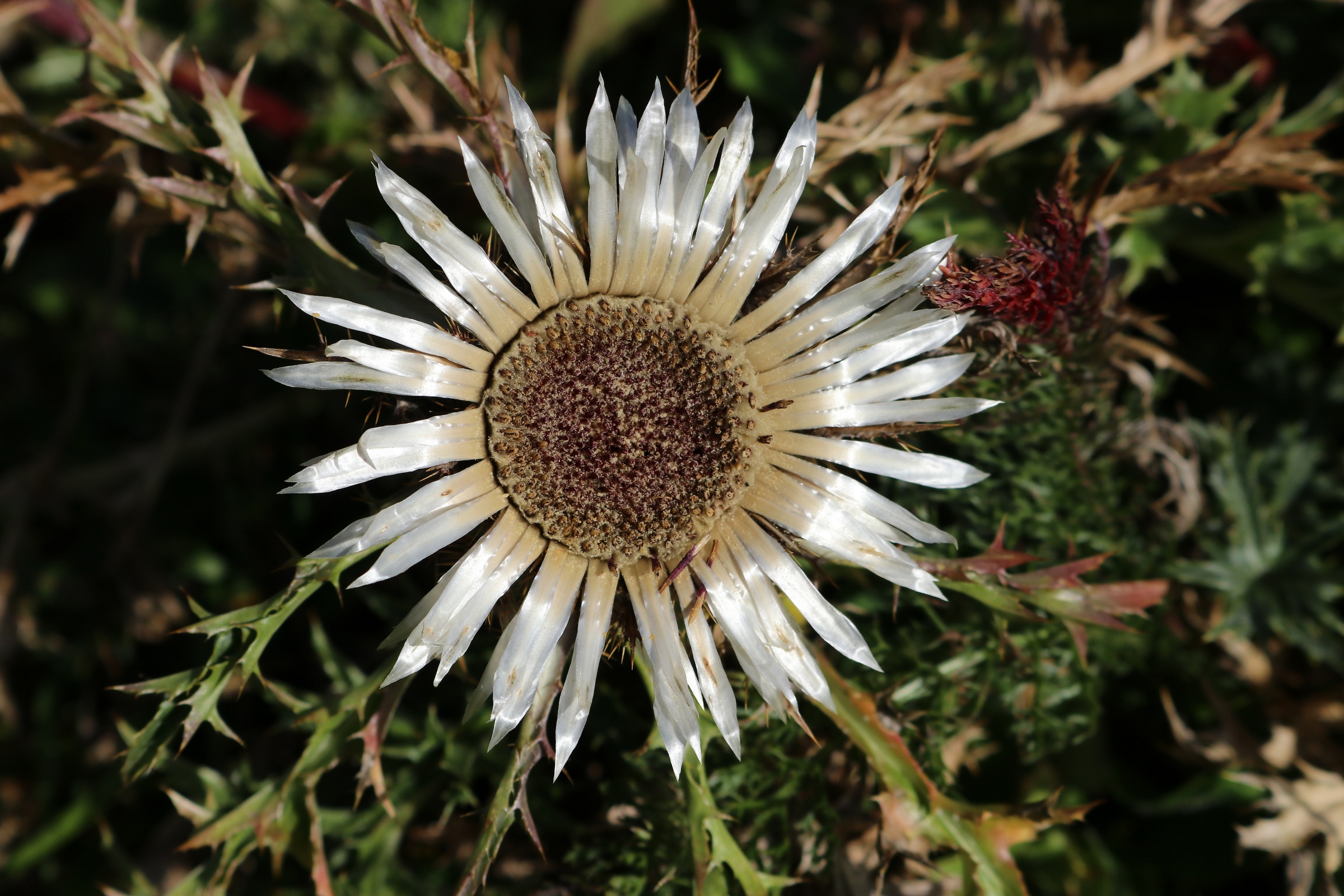
Very similar looking but with long stem, the “curlyleaf silver thistle” (Carlina acaulis ssp. caulescens).
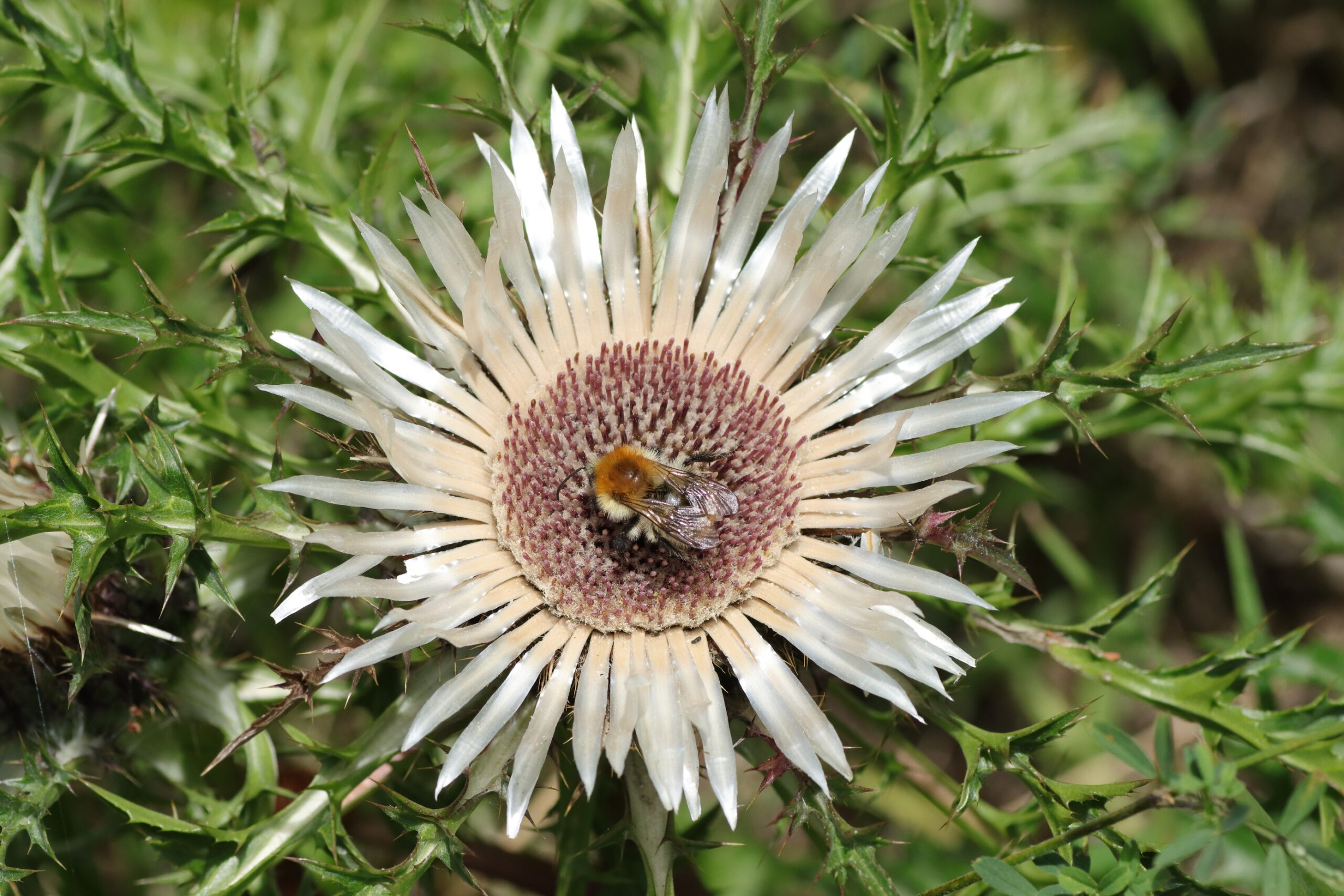
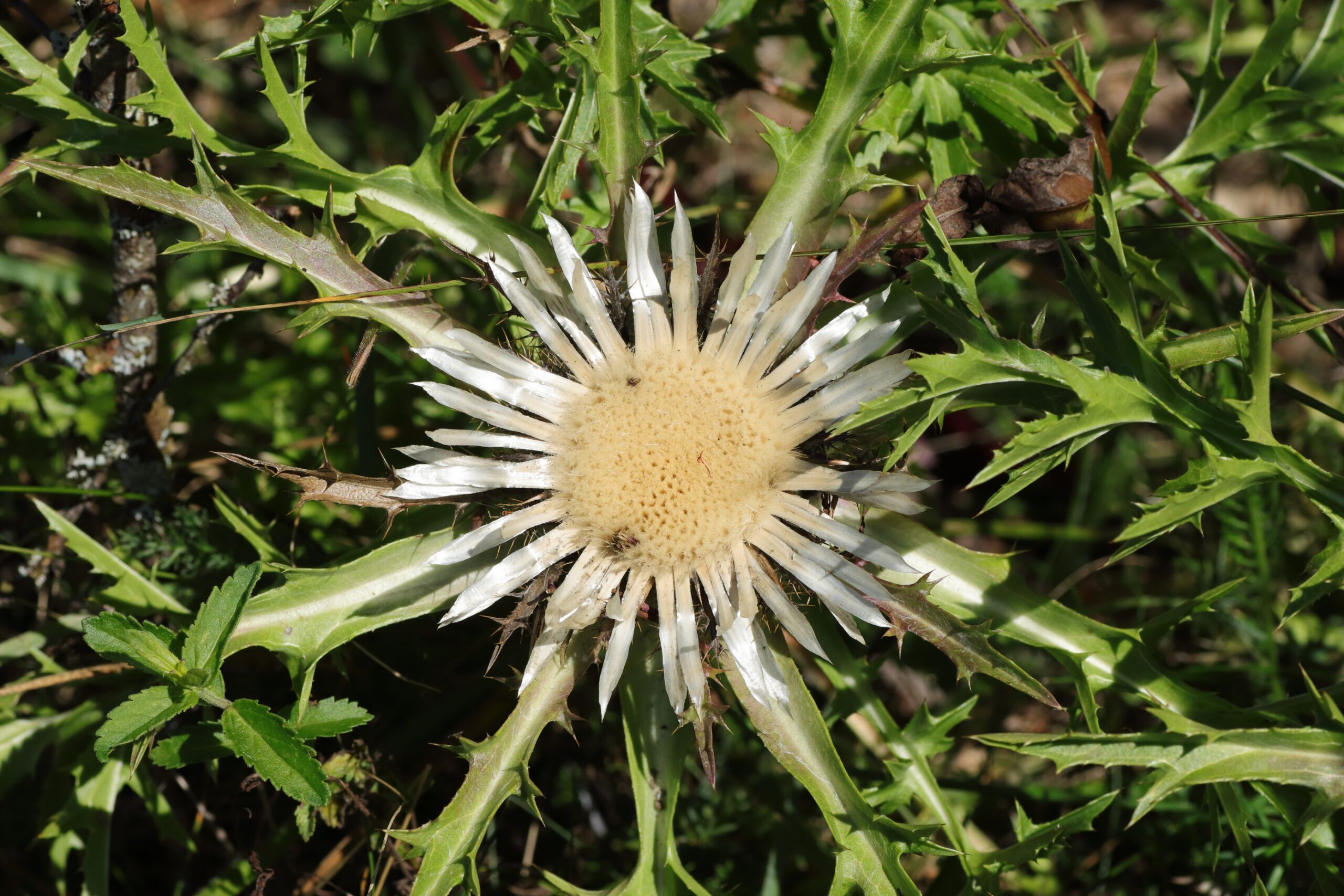
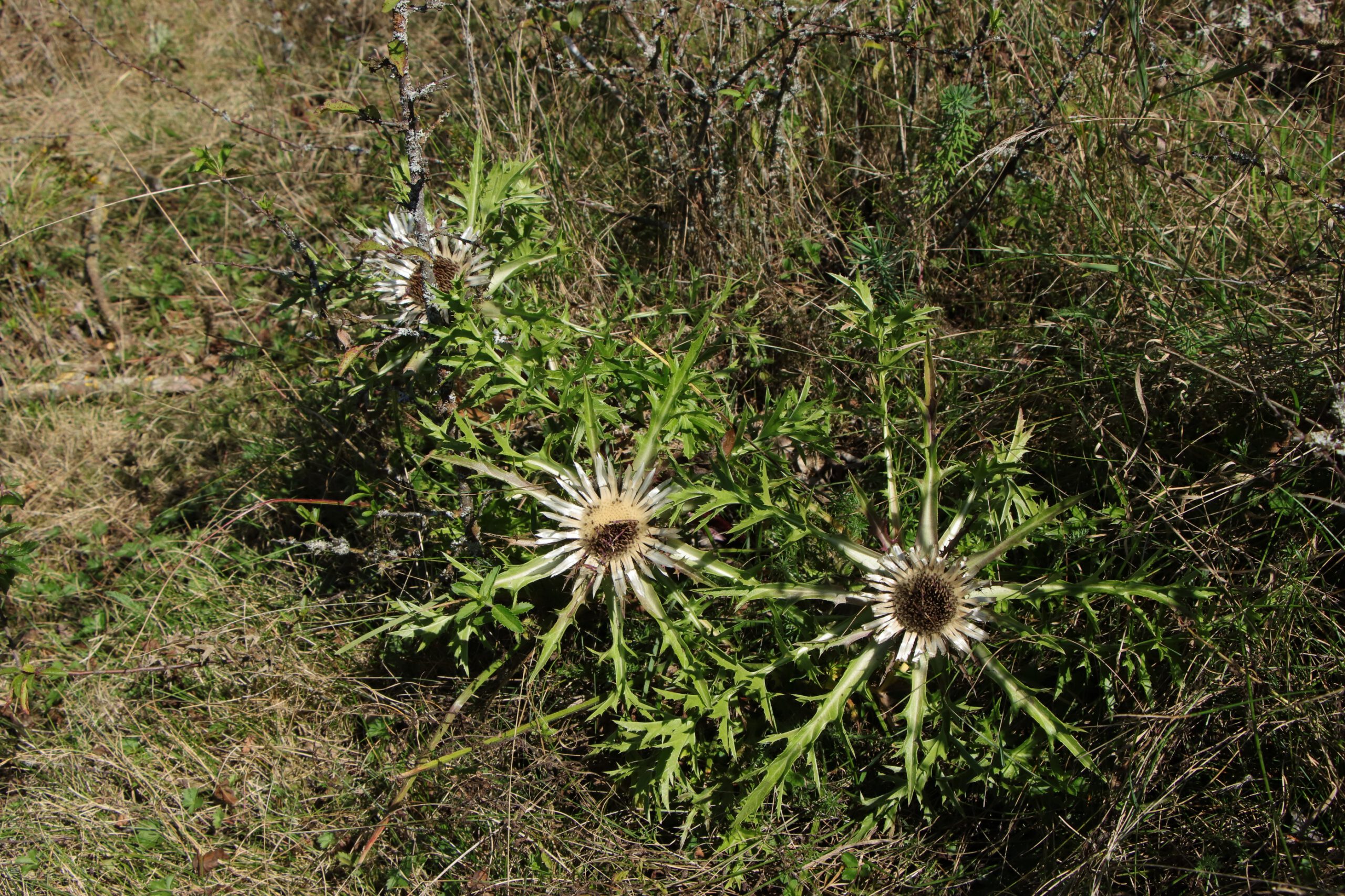
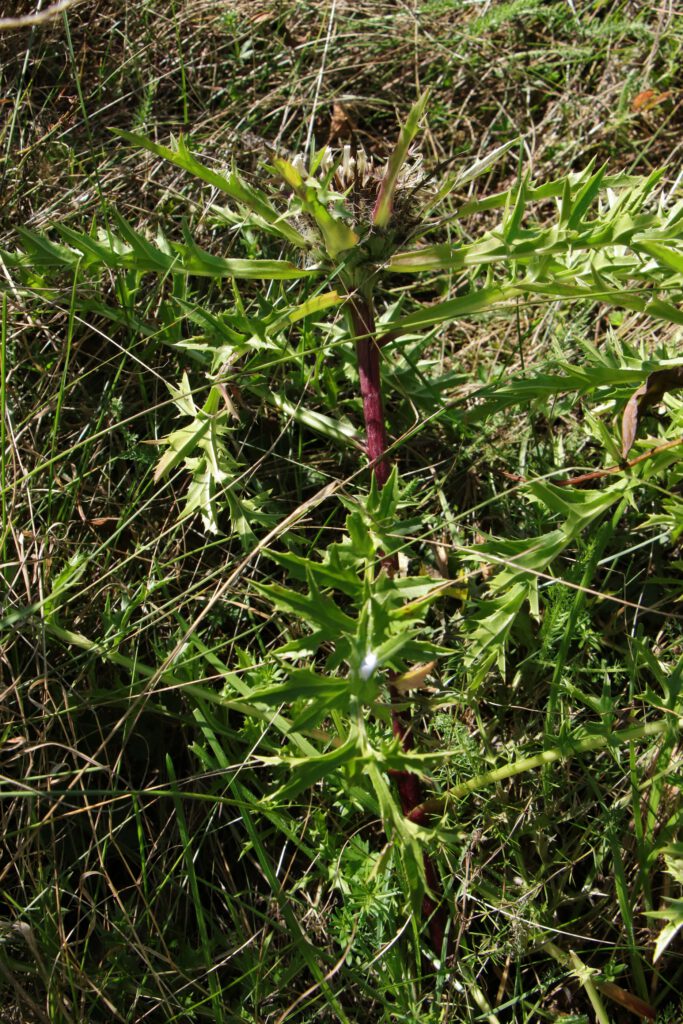
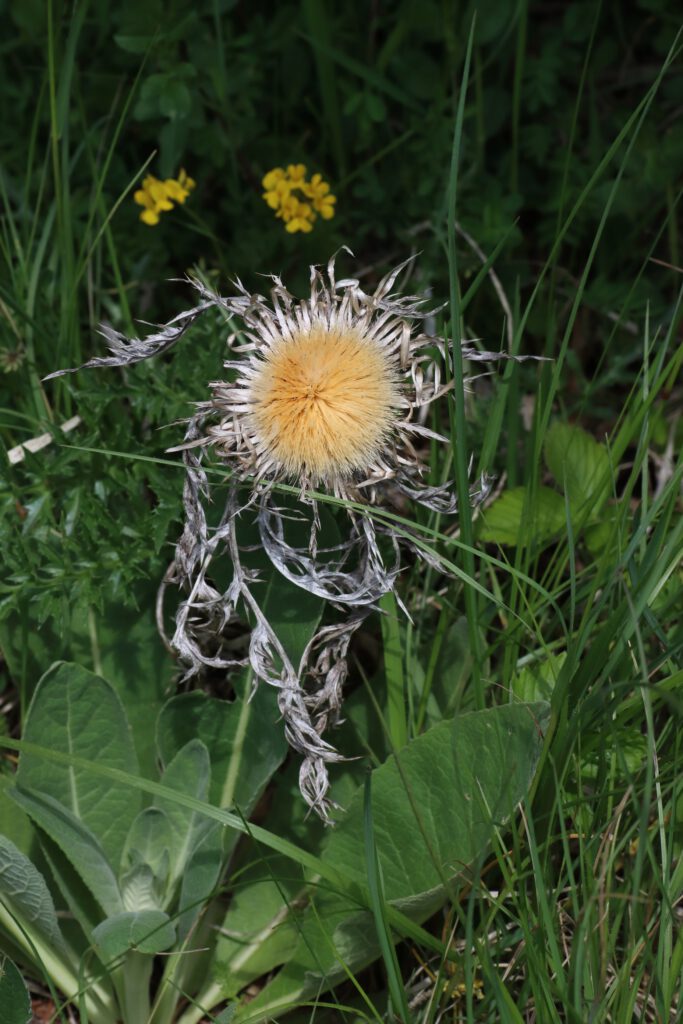
~ specially protected species / weak poisonous plant ~
Occurrence and distribution: The silver thistle grows for example on dry rough grasslands and in sparse forests. It is mainly found on calcareous grasslands without fertiliser. The main distribution areas are the mountains of Central and Southern Europe. Especially the Alps, the Bavarian Forest and the Swabian Alb. In the high mountains it grows at altitudes of 2,800 metres above sea level. Both sub-species can be purchased in specialist shops for use in rock-gardens. As the stony locations (preferred location of the plant) are becoming rarer and rarer, the wild plants should not be taken from the wild under any circumstances.
Plant description
In the case of silver thistle, there are clear differences between the subspecies. These will be explained in more detail in these next parts:
Common silver thistle / Stemless silver thistle
Growth habit: The plant grows low to the ground. It reaches a height of between 1,2 in to 3,9 in (3 and 10 cm). It is a perennial, herbaceous plant. Often only a very short stem forms below the flower, on which the leaves are attached. The stem has a slightly reddish-green colour.
Leaves: The leaves of the common silver thistle are flat to moderately curly. They are pinnately divided and have pointed spines at the end. The leaves are very close to the ground. The leaves can reach a length of between 2 in to 5,9 in (5 and 15 cm). In autumn / winter the plant withers. The leaves and stems turn silvery white.
Flowers: The entire flower is white in colour. The inside of the flower is surrounded by a multitude of spiky petals. These are white in colour and have a silvery sheen. The centre of the flower consists of many individual tubular flowers, which are pink at the edge and white towards the centre. Single flowers can reach a diameter of up to 2,8 in (7 cm). The flowering period is from May to September.
Fruits / seeds: The seed pods are dark brown to black in colour. After ripening, these seeds are carried out of the dried flowers for example by touch or the wind. The individual seeds have a small pappus and can therefore fly in the wind. Sometimes goldfinches can be observed on the flowers. They peck the seeds out of the blossom envelope.
Curlyleaf silver thistle / Stem silver thistle
Growth habit: The plant grows upright and has a long stem. It can reach a height of up to 23,6 in (60 cm). It also has a perennial, herbaceous growth habit. The leaves form a rosette directly under the flower. The stem is dark red with a slight green tinge.
Leaves: The leaves of the curly-leaved thistle are very curly along the edges. They are also pinnately divided and have pointed spines at the end. The white midrib is particularly strong at the base of the leaves. Single leaves can reach a length of 5 to 15 cm. The stem is covered with leaves, especially in the upper and middle part. In autumn / winter the plant withers. The leaves and stems turn silvery-white. The centre of the flower then has a golden yellow colour.
Flowers: The entire flower is white in colour. The inside of the flower is surrounded by a multitude of spiky petals. These are white in colour and have a silvery sheen. The centre of the flower consists of many individual tubular flowers, which are pink at the edge and white towards the centre. Flowers can reach a diameter of up to 1,6 in (4 cm). The flowering time is from July to September.
Fruits / seeds: The seed pods are dark brown to black in colour. After ripening, these seeds are carried out of the dried flowers for example by touch or the wind. The individual seeds have a small pappus and can therefore fly in the wind. Similar to the stemless silver thistle, goldfinches can be observed on the flowers. They peck the seeds out of the blossom envelope.
Special characteristics for insects
Food plant for insects: The flowers of the silver thistle are especially popular with butterflies and bumblebees / bees. The flowers are pollinated by long-tusked insects as the tubular flowers can reach a length of up to 0,4 in (10 mm). The petals are easily visible to insects due to the reflection of UV rays. A beetle species that specialises in the silver thistle is the thistle weevil (Larinus pallinis). It pollinates the flowers, for example. However, its larvae live in the flower base and feed on the flower there.
Former use as a medicinal plant & in the kitchen
Former use as a medicinal plant: In folk medicine, the root and herb of the silver thistle were used against influenza and as a diuretic. In veterinary medicine it was common to use the roots as oestrus or fattening powder. The root contains essential oils such as “carlina oxide”. These have an antibacterial effect, for example. At the same time, however, they are toxic when used internally! Self-medication with the plant is therefore strongly discouraged!
Earlier use in the kitchen: The young leaves and the flower base were also partly used in the kitchen in the past. These were prepared similarly to artichokes or eaten raw. This is also where the popular name “Jägerbrot” (hunter’s bread) originated from.
Name origin & Folk Names
Why is it called Wetterdistel (weather thistle)?
The silver thistle has long been regarded as a “weather prophet”. This is because at night and in damp weather, the “Wetterdistel” (weather thistle) closes its petals inwards to protect the sensitive flower inside. This phenomenon can also be observed even before it rains, as the humidity often rises early on. Thus the flowers form a good weather indicator. They can already “predict” the changes in the weather.
How do silver thistles and the Emperor Charlemagne fit together?
According to an old legend, an angel appeared to Emperor Charlemagne, who was born in the Gautinger Reismühle, in a dream. He showed him a prickly flower in the middle of the dry grass. “This will help you and your army against the plague”. It also owes its Latin name to the emperor: “Carline acaulis”. For, according to legend, through the hint of the heavenly angel, the “Feldscher” (the medical staff of his army) were able to save the army from demise by the plague. In older literature, it is also called the ” Karlsdistel” in honour of the emperor. This is also reflected in the Latin generic name “Carlina”. This is the Latin diminutive of “cardulina” – derived from the word “cardus” – which can be translated into English as “thistle”.
Where does the name Eberwurz (Boar’s Root) come from?
In folk dialect it is also called Eberwurz (Boar’s Root). A silver thistle is said to strengthen the strength and endurance of those who pick this plant and carry it with them. It is also useful to nail it to the trough of the cattle, especially the pigs. Then those who eat it are protected from disease. But one should also bear in mind that it is under strict protection. Another explanation for the name is said to have been the earthy flower – which is a false derivation. An exact etymological origin of the name is impossible or difficult to determine.
Where does the name Silberdistel (silver thistle) come from?
The plant got its name “Silberdistel” (silver thistle) because of the bright white / silvery petals (even after they have dried up). The part of the name “thistle” has developed after the pinnately divided leaves, as these are reminiscent of the leaves of other thistle species.
How did the name “Jägerbrot” (hunter’s bread) come about?
The name “Jägerbrot” (hunter’s bread) is said to have arisen from the use of the fleshy fruit base of the thistle flower. This explanation is also given according to Unger-Khull (Steirischer Wortschatz als Ergänzung zu Schmellers Bayerischem Wörterbuch, S. 362). The alpine herdsmen also liked to use the plant as a little refreshment. In Tyrol, the plant is known as “Jagabrot” – thanks to @Thomas_Gerl for the info. In Vienna, the plant is also called “Jägerbrot” – thanks to @Robert_Glattau and @Silvia_Jirsa for the confirmation.
Endangerment of the plant
Endangerment of the plant: On the Red List of Germany, the silver thistle with both subspecies is included in the list of potentially endangered species.
All subspecies of the silver thistle are also listed as specially protected species under the Federal Species Protection Ordinance (BArtSchV). They cannot be dug up or picked under any circumstances. Both subspecies can be purchased in specialist shops for use in rock-gardens. The removal of dried specimens from the wild is also prohibited! The individual endangerment levels are as follows:
- Germany: Prewarning level (status: V / V)
- Baden-Württemberg: Prewarning level (status: V / V)
- Bavaria: Prewarning level (status: V / V)
- Hesse: gefährdet (Status: 3 für caulescens)
- Lower Saxony: Critically endangered (status: 2 for caulescens)
- Saxony-Anhalt: endangered (status: 3 for acaulis)
- Saxony: Threatened with extinction (status: 1 for acaulis)
Distribution-codes: A, AV, M1 / A, AV, M1, M2